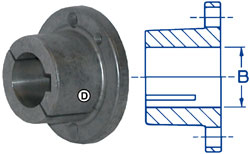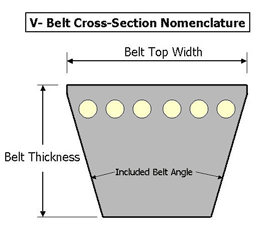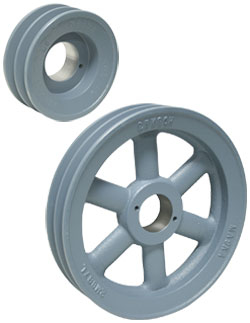We commonly receive the call to help assist in properly sizing pulleys and sheaves for pump applications. Generally, this is in high pressure wash applications but we also run into a fair amount of agricultural applications where this knowledge can be leveraged. Pulleys or "sheaves" are commonly used for connecting pumps to motors or engines via drive belts. Most pulleys are cast iron or aluminum construction and are offered in either fixed-bore or tapered bushing styles.
Why is it Necessary to Size Pulleys for Each Application?
For proper operation of any brand or pump type, it is critical to size pulleys and sheaves, correctly, in order to maintain correct RPM, (revolutions per minute). RPM speed is what determines the pump output flow rate - in gallons per minute, liters per minute, etc.
Incorrect pump RPM will adversely affect the pump performance. If the pump is turning too slow - it will not give full performance. Conversely, if the pump is turning too fast, it could cause premature mechanical failures (i.e. valve wear or elastomer failure).
Therefore, it is absolutely critical to ensure correct pulley sizing and analysis of the drive unit, (motor, engine, etc.) relative to the pump. For the sake of this discussion, we will assume standard electric motors at 1750 RPM and standard gas engines at 3400 RPM. Do note, one must determine the rpm of their drive unit to be able to accurately calculate the pulley/sheave size.
If you start with an incorrect figure for RPM - you will size your equipment incorrectly. This could lead to shorter equipment lifespans and/or reduced output flow rates. Thus, ultimately a less efficient system which equates to more down time and added cost of operation. The scope of this post will be focused towards plunger pump applications. We assemble many units using this method in Omaha, Nebraska. Dultmeier Sales is proud to display the Built in the USA logo on our products. Here are just a handful of the pulley-driven pump products that we offer.
The Math of Pulley Sizing
There are complicated formulas for determining pulley ratios but in generic, layman terms, simply divide the driven component (pump) by RPM, the driver component (motor or engine) rated by RPM to get the required ratio. In the example below, the pump RPM is 1070, for full output, while the motor is 1750 RPM.
Therefore, the ratio of the required pulleys would be:
1070 (pump RPM) divided by 1750 (motor RPM) = .611
This means the pulley ratio must be .611 to drive the pump correctly. Hypothetically speaking, if we had a 4 inch pulley on the motor, we would require a 6.55" pulley on the pump. That mathematical equation is as follows: 4" divided by .611 = 6.55"
For the same pump, driven by a gas engine
1070 (pump RPM) divided by 3400 (engine RPM) = .315
If the drive pulley on the engine is 4 inches in diameter, we need to calculate 4/.315 = 12.70. This means that the pump pulley must be 12.70 inches, in diameter, to run the pump at 1070 rpm. You can view a technical page from our catalog here - it will help to further explain the calculation process.
Tapered Bushing vs. Fixed Shaft Bores
Most pulleys, or sheaves, are designed with either fixed shaft bores or tapered bushing hubs. Replaceable hubs fit the required motor or pump shaft size in either inch or mm sizes - depending on the application requirement. These hubs come with bolts to attach them to the pulley, or sheave.

Tapered style hubs simply fit into the pulley opening and then are tightened with two or three set screws, which draw the bushing and pulley together to make one assembly. The pulleys are then attached to the driver (electric motor or gas engine) and driven components (pump). The type of hub, H, SD, SH, etc. must match to a pulley with the same designation for proper fit.
Therefore, make sure to identify what type of hub you have PRIOR to ordering.
Pulleys can be measured in a number of ways. Two of the most common methods are belt pitch and outside diameter (O.D.). When using the, most common A/B, belt pitch method, one must identify both A belt pitch and B belt pitch. This is the pitch diameter of the V-belt you are using, (A/B) is the measurement of how the belt fits into the groove of the pulley.

A belts are not as wide as B belts and, therefore, sit lower in the pulley groove. While this may seem as a minor detail - it absolutely affects the ratio measurement when properly sizing a pulley.
Pulleys are available with different numbers of grooves. The number of grooves matches the number of belts that the pulley will accept. A two groove pulley will accept two V-belts. A single groove pulley will only accept one belt.
Again as a general rule, (but not intended to use in every application) single groove pulleys with single belts can be used up to about 5 horsepower. Two groove belts can be used from 5-15 horsepower and three groove belts up to 25 horsepower. Use this as a general guideline but always make sure you consult us if you are unsure of your application needs.

Two Groove Pulleys
For correct belt sizing, there are charts available that show the sum of the pulley diameters and the center distance they are apart, from each other. We will be happy to supply you with one of those charts if you wish to have a copy.
For instance, the sum of the two pulleys, in the above electric motor example is 4 inches + 6.5 inches = 10.5 inches. The mathematical equation to figure this out is as follows:
A - Pump Pulley O.D. B - Motor Pulley O.D.
Belt Size = [A*1.57] + [B*1.57] + [2*center distance between pulleys]
76.5 = [4*1.57] + [6.5*1.57] + [2*30]
If the pulleys are 30 inches apart, center to center, then the required belt length would be 77 inches.
As the information above shows, there are many things involved in order to determine the correct pulleys required to drive your pumps correctly. It is important to remember the larger the difference in pulley sizes, the larger the center distance required to maintain minimum contact with the smaller pulley. We would be glad to help with any sizing for your specific applications. Your Experts in Delivering Fluid Handling Solutions - We Know Flow!












